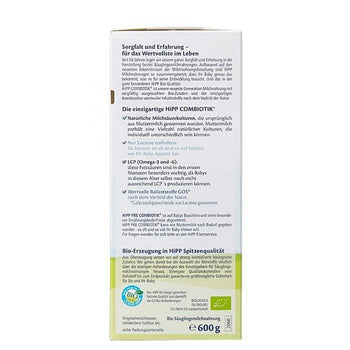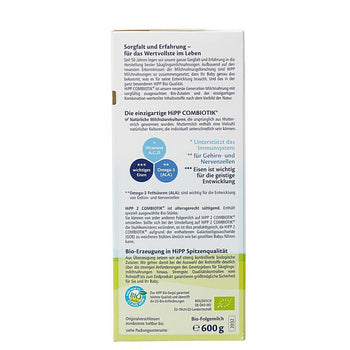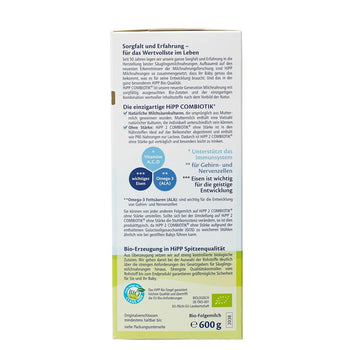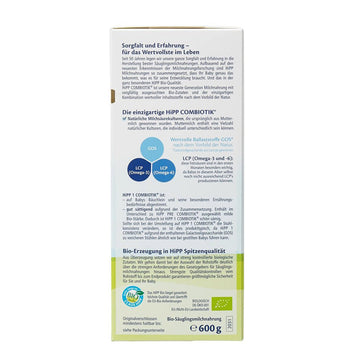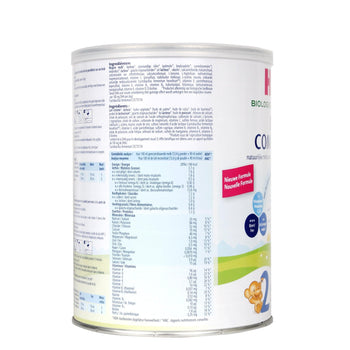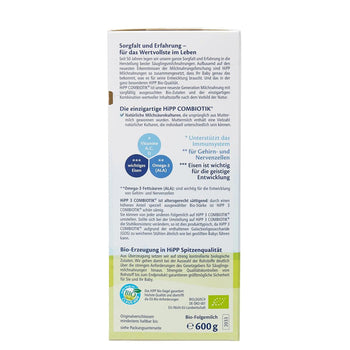Table of Contents
- Understanding Modern Formula Health Standards
- What Makes Formula "Healthy"?
- Complete Nutritional Breakdown: What's Really in Formula
- Specialized Additives in Premium Formulas
- The Health Reality: Organic vs. Conventional Formula
- Current Safety Concerns: The 2025 Reality Check
- Which Formulas Test Safest?
- Regional Differences: Why European Formulas Lead in Health
- Making Healthy Formula Choices: Your Decision Framework
- The Bottom Line: Formula Can Be Remarkably Healthy
- Your Next Steps
- Informed Choices Lead to Healthy Babies
The short answer: Modern baby formula is remarkably healthy and nutritionally complete when properly manufactured and regulated. However, significant differences exist between formula types, brands, and regulatory standards that every parent should understand before making feeding decisions.
With 8.7% annual growth in the premium formula market and increasing scrutiny over contaminant levels, parents are asking deeper questions about formula health than ever before. Recent Consumer Reports testing of 41 formulas revealed both concerning findings and reassuring news. While half contained potentially harmful contaminants, the other half showed excellent safety profiles, proving that truly healthy options exist.

Understanding Modern Formula Health Standards
Baby formula has undergone dramatic improvements since its inception. Today's formulas must meet stringent nutritional requirements and undergo extensive safety testing. However, not all formulas are created equal, and understanding these differences is crucial for your baby's health.
↑ Back to topWhat Makes Formula "Healthy"?
Complete Nutritional Profile: All FDA-approved formulas must provide adequate nutrition for healthy infant growth, containing precise ratios of proteins, carbohydrates, fats, vitamins, and minerals.
Digestibility: Premium formulas use easily digestible proteins and carbohydrates that closely mimic breast milk composition.
Safety Standards: Manufacturing facilities undergo regular inspections, and finished products are tested for bacterial contamination and nutritional accuracy.
Bioavailability: Nutrients must be in forms that infants can easily absorb and utilize for development.
↑ Back to topComplete Nutritional Breakdown: What's Really in Formula
Macronutrients: The Foundation
Proteins (1.2-1.7g per 100ml): Modern formulas achieve optimal whey-to-casein ratios of approximately 60:40, closely matching breast milk. European formulas like HiPP and Holle often use partially hydrolyzed proteins for enhanced digestibility, reducing the risk of colic and digestive discomfort.
Carbohydrates (6.5-8.0g per 100ml): Lactose dominance is crucial for healthy development. European regulations require at least 30% of carbohydrates to come from lactose, while US formulas may rely heavily on corn syrup solids. Lactose supports calcium absorption, promotes beneficial gut bacteria, and has a lower glycemic index than processed sugars.
Fats (3.0-4.4g per 100ml): Premium formulas include essential fatty acids DHA and ARA for brain and eye development. European formulas must include DHA by law, while it remains optional in many US formulas. Quality fat sources include organic vegetable oils, with many European brands avoiding palm oil due to digestibility concerns.
Micronutrients: The Development Enhancers
Vitamin D: Essential for bone development, ranging from 1.0-1.4μg per 100ml
Vitamin A: Supporting immune function and vision development
B-Complex Vitamins: Crucial for neurological development and metabolism
Vitamin E: Antioxidant protection for developing cells
Iron: Carefully balanced at 0.15-3mg per 100kcal to prevent deficiency without causing digestive issues
Calcium & Phosphorus: Optimal ratios for bone mineralization
Zinc: Supporting immune function and growth
Specialized Additives in Premium Formulas
Prebiotics & Probiotics: European formulas like HiPP include specific probiotic strains (L. fermentum) and prebiotic fibers (GOS/FOS) that support digestive health and immune development. These additions help establish healthy gut microbiomes similar to those of breastfed infants.
Nucleotides: These building blocks of DNA and RNA support immune function and intestinal development. Premium formulas include specific nucleotide profiles that mirror breast milk composition.
Human Milk Oligosaccharides (HMOs): Cutting-edge formulas now include synthetic versions of these complex carbohydrates that were previously exclusive to breast milk, supporting immune and cognitive development.
↑ Back to topThe Health Reality: Organic vs. Conventional Formula
Organic Formula Advantages
Cleaner Ingredient Sourcing: Organic formulas must contain 95% organic ingredients, compared to just 70% for conventional US formulas. This means:
- No synthetic pesticides or herbicides
- No GMOs or artificial growth hormones
- Grass-fed, pasture-raised dairy sources
- Stricter manufacturing standards
Superior Carbohydrate Sources: Organic formulas predominantly use lactose rather than corn syrup, supporting better digestion and nutrient absorption. This is particularly important for sensitive babies who may struggle with highly processed sugars.
Enhanced Fat Quality: Organic dairy contains higher levels of omega-3 fatty acids and beneficial compounds like CLA (conjugated linoleic acid) due to grass-fed sourcing.
Conventional Formula Benefits
Cost Accessibility: Conventional formulas provide complete nutrition at lower costs, making adequate infant nutrition accessible to more families.
Wide Availability: Conventional options are readily available in most stores, reducing supply chain concerns during shortages.
Specialized Medical Formulas: Many therapeutic formulas for specific medical conditions are conventional rather than organic, as the processing required for medical modifications may conflict with organic standards.
↑ Back to topCurrent Safety Concerns: The 2025 Reality Check
Heavy Metal Contamination: Recent Consumer Reports testing revealed concerning realities about formula contamination:
- Lead Presence: Found in nearly all tested formulas at levels of 1.2-4.2 ppb, though below FDA targets. Eighteen formulas showed lead intake levels between 50-100% of California's stricter safety limits.
- Arsenic Concerns: Eight of 41 tested formulas exceeded safe intake levels based on drinking water standards, with total arsenic ranging significantly between brands.
The Good News: Twenty-one formulas earned "Top Choice" ratings with low or undetectable contaminant levels, proving that truly safe options exist.
↑ Back to topWhich Formulas Test Safest?
Based on independent testing, European organic formulas consistently show lower contaminant levels due to:
- Stricter EU environmental regulations
- More rigorous ingredient sourcing standards
- Enhanced quality control measures (HiPP conducts 260+ safety checks per batch)
- Prohibition of problematic ingredients like corn syrup
Regional Differences: Why European Formulas Lead in Health
Regulatory Superiority
Ingredient Standards: European Commission regulations are significantly stricter than FDA requirements:
- Mandatory DHA inclusion since 2020
- Prohibition of artificial sweeteners and corn syrup
- Required minimum lactose content
Manufacturing Oversight
EU facilities undergo more frequent and comprehensive inspections, with many brands exceeding minimum requirements through additional certifications like Demeter (biodynamic) standards.
Nutritional Optimization
Stage-Specific Formulation: European formulas use precise age-staging (PRE, Stage 1, 2, 3, 4) that adjusts protein levels and nutrients based on developmental needs, rather than the US approach of one formula for 0-12 months.
Clean Label Philosophy: European brands prioritize ingredient transparency and minimal processing, avoiding unnecessary additives that may impact long-term health.
↑ Back to topMaking Healthy Formula Choices: Your Decision Framework
Read Beyond Marketing Claims: Focus on ingredient lists rather than front-panel promises. Look for:
- Lactose as the primary carbohydrate
- Whey-dominant protein ratios
- DHA and ARA inclusion
- Minimal synthetic additives
Consider Your Baby's Individual Needs:
- Sensitive stomachs: Choose partially hydrolyzed proteins or goat milk options
- Allergy concerns: Select hypoallergenic formulations
- Digestive issues: Prioritize formulas with prebiotics/probiotics
Quality Indicators to Seek:
- Third-Party Testing: Choose brands that conduct extensive safety testing beyond regulatory minimums. European brands like HiPP publish detailed testing protocols and results.
- Organic Certification: While not essential, organic certification indicates cleaner ingredient sourcing and stricter manufacturing standards.
- Transparent Sourcing: Premium brands provide detailed information about ingredient origins, farming practices, and manufacturing processes.
The Bottom Line: Formula Can Be Remarkably Healthy
Modern baby formula, when properly manufactured and appropriately chosen, provides excellent nutrition for infant development. The key lies in understanding quality differences and selecting products that prioritize safety and nutritional optimization over cost savings.
European organic formulas represent the current gold standard for infant nutrition, offering:
- Superior ingredient quality and sourcing
- Stricter safety standards and testing
- Optimized nutritional profiles that closely mimic breast milk
- Lower contaminant risks
However, many conventional formulas also provide adequate nutrition when organic options aren't accessible or affordable. The most important factor is choosing a formula that your baby tolerates well and meets their individual developmental needs.
↑ Back to topYour Next Steps
- Consult Your Pediatrician: Discuss your baby's specific nutritional needs and any health concerns that might influence formula selection.
- Research Thoroughly: Use independent testing results and ingredient analyses rather than marketing materials to guide decisions.
- Start with Quality: Consider investing in premium formulas during the crucial early months when nutritional foundations are being established.
- Monitor Your Baby: Watch for signs of contentment, healthy weight gain, and comfortable digestion; these indicate successful formula nutrition regardless of brand.
Informed Choices Lead to Healthy Babies
Baby formula health isn't a simple binary of "good" or "bad"; it's a spectrum of quality that parents can navigate with proper information. By understanding nutritional profiles, safety considerations, and regulatory differences, you can confidently choose formulas that support your baby's optimal development.
At EuromallUSA, we're committed to providing access to the highest-quality European formulas that meet the strictest safety and nutritional standards. Our carefully curated selection ensures that every product meets our rigorous quality criteria, giving you confidence in your feeding choices.
Ready to explore the healthiest formula options for your baby? Browse our complete selection of premium European organic formulas, backed by decades of nutritional science and manufacturing excellence.
↑ Back to top














